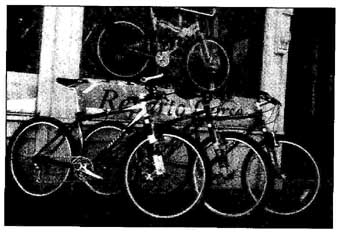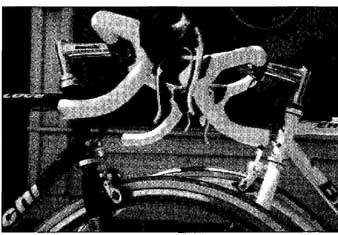So you have decided to buy a new bike. Whether you’re new to the sport or an old hand looking for a new steed, this guide will help you go about it as effectively as possible. You’ll get straightforward answers to the questions you might ask, and you’ll learn what questions to ask in the bike shops you visit.
One thing you won’t find here is a listing of all the makes and models of bikes available in different bike shops and other outlets where bikes are sold. However useful such a list may seem, it’s very transitory information: much of the information will be outdated by the time the list is published. Models are dropped, specifications are changed, prices are revised, and availability may be uncertain. Besides, what you really want to know is which bike is best for you, rather than a general listing of all the bikes available.

FIG. 1. An assortment of new bikes (an Electra cruiser, a Bianchi hybrid,
a Bianchi road bike, and a Breezer full suspension mountain bike) waiting for
buyers at a bike shop in California.
In this guide, you’ll learn what features to look for to get a bike that is most suitable for your kind of use. (Yes, it says “a bike,” not “the bike,” because there will be several makes and models that are suitable, and their pricing will be so competitive that only you will be able to make the right choice between them.
Where to Buy
Bikes, even quite sophisticated ones, are available at many different outlets. Bike shops, general sporting goods stores, mail-order catalogs, and department stores all offer bikes. My general advice is to deal only with full-service bike shops. All the other types of outlets have two problems: you don’t get personal, informed service, and you probably can’t go back to have things corrected or fixed (an exception being some of the better sporting goods stores that may have an in-house bike repair department, making them essentially full-service bike shops).
I don’t recommend buying a complete bike from a mail-order/Internet catalog, because size and fit are so critical on a bike that what seems right on paper may turn out to be wrong when you try it out. I’ve occasionally bought certain accessories that were not available from my regular bike shop from a mail-order firm, and it’s astonishing how often even such simple things turn out not to match, or to be defective or disappointing. Although most mail-order houses take exchanges, it’s often more hassle than it would be to just go down to a bike shop and get it there—even if the price may be a little higher.
Not all bike shops are the same. Different stores may carry different brands; they may specialize in a particular type of bike; they may address a different type of clientele; or they may simply have a different attitude or philosophy.
If you are buying a new bike, you want a shop where they’ll take you seriously and try to find what’s best for you, rather than make a quick sale. If you’re an advanced rider, you want a shop where the staff will accept your input and work with you to come up with something that matches your taste and experience.
Good bike shops treat their customers with respect, take time to answer questions, and enjoy repeat business from loyal customers. Jacquie Phelan, the famed pioneer of women’s mountain biking, gives some tongue-in-cheek advice for finding a good bike shop in her contribution to my guide, The Original Mountain Bike Book. Here it’s in condensed form:
“Take a yardstick and stand against a door jamb, mark off your height and measure it. Remember this number in inches or centimeters. Then, with no intention of buying a bike, walk into the store, peruse the bikes, and hang out at the counter. You’re simply testing the particular shop for its warmth—a great indicator of its ability to serve you. When someone asks if they can help you, say the usual, ‘No, I’m just looking, thanks.’
“Now leave the shop, run back to your doorway, and measure your new height, after interacting with the shop. If the number is smaller than what you originally measured, find a new shop—those people rely on the brilliant tactic of humiliation to demonstrate their awesome bike knowledge. If the number is equal to or greater than your original height, it’s a good shop. Head back there and buy a bike. They are happy to share their enthusiasm, even if you are just a fledgling and don’t know what it’s all about. I don’t believe that the brand of bike is as important as the attention given to fit and follow-up. Excellent service is what you really need from a shop.”
The message is simple: a bike shop where you feel respected is likely to give you the attention and personal service you deserve. Find such a shop, but don’t be shy about shopping around, and if one shop has a nice attitude, but not the right bike for you, find another shop—one that has both the attitude and the bike you want.
Types of Bikes
Walk into a bike shop and the odds are that what you see are mountain bikes, mountain bikes, and more mountain bikes. But that does not mean there aren’t plenty of choices available, and you certainly don’t have to settle for a generic bike that’s indistinguishable from everybody else’s. In fact, there probably are more different types and subtypes of bikes available these days as at any time in the past. (Only 20 years ago, you could have walked into that same shop and found ten-speeds, ten speeds, and ten-speeds, and much less variety than there is today.)
Not only are there other models available, the mountain bike itself comes in more variants than meets the eye at first. In Section 2, I will show you what’s out there and how you can decide what is most suitable for your purpose. This will all be treated in the most general terms, while in the sections that follow, we’ll first learn to speak the language of cycling and then take a close look at the various parts that make up the bicycle, and how they differ for various types of bike.
The idea is of course not to get just any bike, but one that suits you. There is no such thing as a universal “best buy” for everybody. What is good for you may not be for the next person, nor indeed for you five years from no when your interest in cycling has evolved. Think about the way you’re going to use the bike—on the road, off-road, or both; daily, weekly, or infrequently; long distances or short trips; commuting, touring, training, or racing. Explain that to the sales personnel in the shops you visit, so they know what direction to steer you.
Bicycle Brand Names
There are literally dozens of different bicycle makes out there, both big and small. Actually, in terms of numbers of bikes produced, the respectable manufacturers whose wares are sold through the bike trade are small compared to some of the manufacturers represented elsewhere. The largest bike trade brands are Trek, Cannondale, and Specialized, while Trek actually owns several other, smaller brand names, such as Gary Fisher, Klein, and LeMond.

FIG.2 Similar bikes, different makers. These midrange cross country type
mountain bikes from Breeze cycles, Voodoo, and Mann have many things in common.
Whether you buy a bike of one brand or another does not matter very much. In a given price category, they all offer similar quality and they have all installed components from the same limited number of suppliers. They may differ a little in frame geometry (the sizes and angles of the various tubes of the bike’s frame), in cosmetics, and sometimes in materials (today many major manufacturers make only aluminum frames, some use only steel, while others have different model ranges using different materials).
Other Criteria
At least as important as the type of bicycle are its quality and size, but also highly personal criteria can matter. The various types of bikes are described in Section 2. The issue of correctly sizing a bike will be addressed in some detail in Section 4. The other criteria will be discussed here.
Personal preferences are perfectly legitimate. If you don’t like the color, a particular manufacturer’s name, or the model designation on an otherwise perfectly suitable machine, then you may never get used to it. You’ll get more fun out of cycling if you avoid that particular bike. Ask at the bike shop—or at several different shops—what other makes, models, and colors are available in that particular category, and select one you like.

FIG. 3:Get a bike that fits you. These two Bianchi road bikes are representative
of the wide range of sizes available for high-end bikes.
Buying a Bike
Weight is another factor. By and large, a lighter bike is nicer to ride, all else being the same. But sometimes weight may be saved at the expense of other more important criteria. The major one of these “other criteria” is usually cost: shedding pounds on a bike is a very expensive business. See whether you can live with a bike that’s just a pound heavier and save yourself a bundle, or invest some of the money you save on a slightly heavier machine in an upgrade, such as extra accessories you want, a more comfortable helmet, or something else that’s important to you.
Quality is of course the most important criterion, but how can you judge it? The first rule of thumb is that, within limits, you get what you pay for. If two bikes look similar but one is 50 percent more expensive than the other, it’s unlikely that the cheaper one is just a better deal: more likely, the more expensive machine is simply the better product. The frame on the more expensive bike may be lighter or more accurate, the components may be of a higher quality material, or they may be more accurately machined. Ask what the differences are and how important they are for your particular kind of use.